- Home
- The Summer Garden
- Summer Flowering Shrubs
Summer Flowering Shrubs
Summer flowering shrubs are often overlooked when planning a garden, which is a pity because there are some great ones to choose from. After the spectacular prima donnas of spring—the azaleas, the forsythias, the lilacs, the viburnums—have faded, what do we do for an encore? How about including some of the great choices below? Some are very well known, and others deserve a wider planting. Butterfly bushes, for instance are great for summer color, bloom for a long time and attract bees and butterflies like mad. Hydrangeas are a must, and you can choose species that will give you blooms all summer from the huge white puffballs of Hydrangea arborescens ‘Annabelle,’ to the pink or blue mopheads or lacecaps of H. macrophylla to the later blooming H. paniculatas that often turn from white to rose to red as they mature.
One that I am eager to try is Fuchsia magellanica, hardy fuchsia, if I can find one. I haven’t seen them in my local nurseries, so we will see.
Abelia x grandiflora, glossy abelia, Zones 6-9. I inherited a number of these shrubs when I moved in 2016. They were vastly overgrown—almost 7’ tall--full of dead wood and leggy. I left them alone the first year and they bloomed and were good butterfly attractants. But they needed to be rejuvenated, so I cut them back severely in late winter, and they responded beautifully. Mine grow in a shady area, they bloom well, but not as heavily as they would in full sun. I love that they bloom from summer until frost and are lightly scented.
There are some marvelous new varieties in smaller sizes with interesting variegated foliage such as ‘Mardi Gras’ with variegated white-margined green foliage, pinkish new growth, and reddish stems on compact plant. The Southern Living Plant Collection has several beautiful ones including 'Kaleidoscope' which changes from gold and green in the spring to orange-red in the fall; ‘Miss Lemon™’ (also known as ‘Hopley’s), with green leaves edged with cream and pale pink flowers; Suntastic™ ‘Radiance’ has creamy yellow-edged green leaves that mature to a silver-green and cream with white flowers at a compact size of 2-3.’
 Abelia x grandiflora
Abelia x grandiflora Abelia x grandiflora 'Mardi Gras'
Abelia x grandiflora 'Mardi Gras' Abelia x grandiflora 'Radiance'
Abelia x grandiflora 'Radiance'Abutilon x ‘Orange Hot Lava,’ hardy flowering maple, Zones 7b-10b. Though the common name is flowering maple due to its maple-like leaves, it is not a maple at all, but a member of the mallow family as the flowers will attest. They make great container plants for the summer, and if provided excellent drainage in winter, should return in spring in our temperate zones. Those in northern climes should treat these as summer annuals, or bring them in for the winter as houseplants. ‘Orange Hot Lava’ is a particularly colorful hybrid of A. megapotanicum with red-veined orange flowers emerging tissue-like from burgundy calyxes; and the show continues all summer into fall. Bees and hummingbirds go crazy over them.

Aesculus parviflora, bottlebrush buckeye, Zones 4-8. A very handsome native summer flowering shrub that forms large thickets through suckering and produces long, showy panicles of white flowers in early summer. The long stamens extend beyond the petals giving the "bottlebrush" effect. Unmistakable in flower, and good yellow fall color, too. A good choice for a semi-shady location at the edge of a woodland.
 Aesculus parviflora
Aesculus parvifloraBuddleia davidii, butterfly bush, Zones 5-9. Butterfly bushes are synonymous with summer. Bees and butterflies flock to them and they bloom prolifically summer into fall. Deadheading helps prolong the bloom and helps keep the plant tidy as the old panicles turn dark. Since the shrub flowers on new growth, it is best to prune it nearly to the ground in spring to rejuvenate and induce heavy blooming. The species can get quite large—as much as 10 to 15’—but can be kept in bounds by annual pruning. Also be aware of a tendency to self-seed. I experienced this when I bought a house that came with a huge, unkempt buddleia in the backyard with numerous offspring all over the place. It was interesting that the babies were all different colors from the mother plant. Smaller cultivars have been developed such as ‘Blue Chip,’ which only reaches 2-3.’ There are many cultivars to choose from in shades of white, pink, rose, lavender, and purple including ‘Black Knight,’ dark purple; 'Butterfly Heaven,' lilac; ‘Harlequin,’ fragrant red-purple with variegated foliage; ‘Miss Molly,’ red; ‘Miss Violet,’ violet; ‘Pink Delight,’ pink; and ‘White Profusion,’ white.
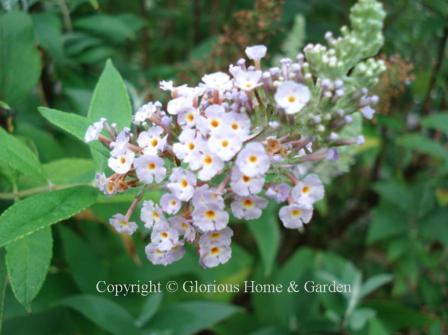 Buddleia davidii 'Butterfly Heaven'
Buddleia davidii 'Butterfly Heaven'Callicarpa americana, American beautyberry, Zones 7-11. OK, not particularly showy in bloom, but the tiny pale lavender-pink flowers encircling the stems foretell the rich purple berries to follow in the fall.
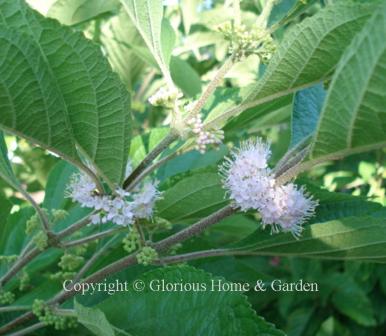 Callicarpa americana
Callicarpa americanaCaryoperis x clandonensis, blue-mist shrub or bluebeard, Zones 6-9. This small shrub is neat and tidy all summer waiting quietly in the background until its moment of glory when it covers itself with blue flowers from late summer into fall. Because it blooms on new wood, and to keep it in bounds, it can be cut back hard in late winter. Bees and hummingbirds will love you for it. ‘Longwood Blue’ is shown.
 Caryopteris x clandonensis 'Longwood Blue'
Caryopteris x clandonensis 'Longwood Blue'Cephalanthus occidentalis, buttonbush, Zone 5-11. This is an unusual native shrub that I first saw at the South Carolina Botanical Garden in Clemson. With its curious round flowers, glossy leaves and long blooming period, buttonbush is a good choice for naturalized areas especially with moist, even wet, conditions.
 Cephalanthus occidentalis
Cephalanthus occidentalisClethra alnifolia, summersweet or sweet pepperbush, Zones 4-9. Clethra, a summer flowering shrub treasured for its fragrant flowers, a nice choice for the shrub border. Both white and pink cultivars are available.
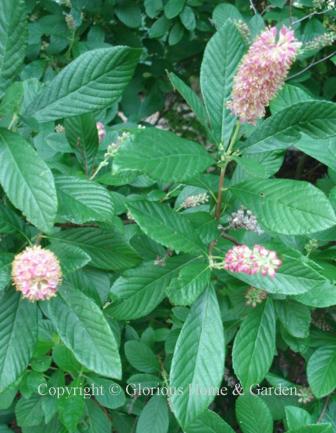 Clethra alnifolia 'Ruby Spice'
Clethra alnifolia 'Ruby Spice'Fuchsia magellanica, hardy fuchsia, Zones 6-9. This shrub, which can grow to about 10' x 6', lends a tropical aura to the summer garden. The bell-like flowers of red with purple centers are attractive to hummingbirds. Though hardy, this fuchsia will die to the ground in winter and regrow in spring. Be sure to provide a well-drained location, as wet winter soils are the leading cause of death.
 Fuchsia magellanica
Fuchsia magellanicaGardenias
Gardenia jasminoides, cape jasmine or gardenia, Zones 7b-10. Late-spring to mid-summer, gardenias blossom in profusion all over the South, and they often have another flush of sweetly scented blooms in the fall. They are often used around patios and pools where their heady perfume sweetens the air. The buds unfurl into waxy white blooms set off by deep evergreen foliage. The drawbacks are the susceptibility to powdery mildew, white flies and other pests, and the fact that the yellowing spent blossoms can be somewhat messy, but the fragrance is worth it. There are several different forms that make gardenias useful for various situations. 'Radicans' is a low-growing spreading shrub with smaller leaves and smaller double flowers (heavy bloom in late May, early June with some repeat blooming in summer); 'Buttons' has small, single daisy-like flowers; and 'August Beauty' is the large double form that you typically associate with gardenias. It can reach 6' in height and repeats until October. ’Aimee’ (also known as First Love®). has large double, exquisite, rose-like blooms, though best for Zones 8-11. New more cold tolerant varieties are being developed and there are some interesting variegated ones as well—such as ‘Variegata.’
 Gardenia jasminoides 'Aimee'
Gardenia jasminoides 'Aimee' Gardenia jasminoides 'August Beauty'
Gardenia jasminoides 'August Beauty' Gardenia jasminoides 'Buttons'
Gardenia jasminoides 'Buttons' Gardenia jasminoides 'Radicans'
Gardenia jasminoides 'Radicans'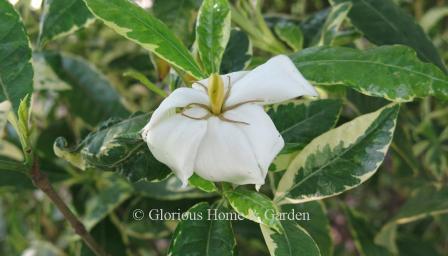 Gardenia jasminoides 'Variegata'
Gardenia jasminoides 'Variegata'Hibiscus syriacus, rose of Sharon or althea, Zones 5-8. This old-fashioned summer flowering shrub blooms in late summer into early fall when few others in the tree/shrub world dare. So, it is useful to provide color in the garden in this transitional time as a hedge, screen or grouping, but is nondescript out of bloom. Beware a tendency to self-seed, and pull up any seedlings that pop up. There are single and double cultivars in white, pink, rose, red and purple.
 Hibiscus syriacus 'Blue Chiffon'
Hibiscus syriacus 'Blue Chiffon' Hibiscus syriacus 'Diana'
Hibiscus syriacus 'Diana'Hydrangeas
For more on hydrangeas, click here for the Hydrangeas page.
Hydrangea arborescens, smooth hydrangea, Zones 4-9. 'Annabelle' is the most popular cultivar of this species for the spectacular round white flowerheads that fade to a refreshingly cool lime green. Truly a beauty!
 Hydrangea arborescens 'Annabelle'
Hydrangea arborescens 'Annabelle'Hydrangea macrophylla, bigleaf or French hydrangea, Zones 6-9. There are two distinct types of H. macrophylla—mophead (or hortensia) and lacecap. Both bloom on new wood so it is important to prune them at the right time (right after they finish blooming) or you may cut off the flower buds for the following year. Both can have pink, blue or lavender flowers depending on your soil chemistry.
 Hydrangea macrophylla 'Dooley,' a mophead
Hydrangea macrophylla 'Dooley,' a mopheadHydrangea paniculata, panicle hydrangea, Zones 3-8. Panicle hydrangeas extend the season blooming after the H. macrophyllas, and often continuing into fall. The large flower trusses change color from green to white and then pink and even red as they mature. ‘Limelight’ is a popular cultivar that can grow to 8-10.’
 Hydrangea paniculata 'Limelight'
Hydrangea paniculata 'Limelight'Hydrangea quercifolia, oakleaf hydrangea, Zones 5-9. Oakleaf hydrangea is another of our great native species, blooming in late spring into mid-summer depending on location. The white flowerheads mature to pink, and finally to brown. 'Snowflake' is a double-flowered form with larger, showier flowerheads than the species. Brilliant fall leaf colors of red and burgundy are a bonus with oakleaf hydrangeas.
 Hydrangea quercifolia 'Snowflake'
Hydrangea quercifolia 'Snowflake'Hydrangea serrata, mountain hydrangea, Zones 6-9. Smaller and daintier in form, leaf, and flower than H. macrophylla, mountain hydrangea is well suited for smaller gardens. H. serrata has both the mophead and lacecap types like its bigger cousin, but the lacecaps are more common.
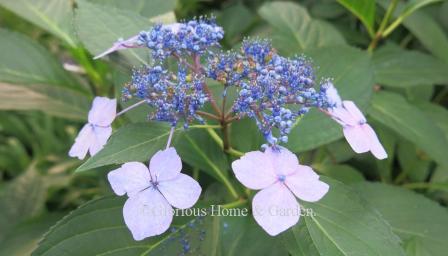 Hydrangea serrata 'Bluebird'
Hydrangea serrata 'Bluebird'Hypericum frondosum, golden St. John's wort, Zones 5-8. The large yellow flowers with a distinctive powderpuff of yellow stamens and blue-green foliage make this southeastern U.S. native a good choice for a sunny spot in the border.
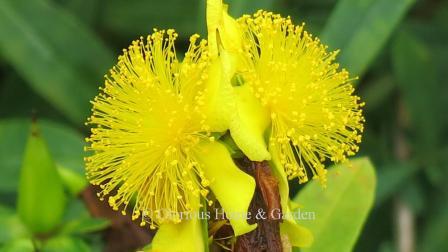 Hypericum frondosum
Hypericum frondosumLespedeza thunbergii, Thunberg lespedeza, Zones 5-8. This is a fast-growing summer flowering shrub with slender arching stems that can be so laden with pea-like flowers that it produces a waterfall effect. A lovely sight for the late summer and early fall garden combined with perennials.
 Lespedeza thunbergii
Lespedeza thunbergiiNerium oleander, oleander, Zones 8-11. Oleander is ubiquitous along the southern coastline and in the Southwest. It tolerates salt spray well, so it is a good choice for coastal areas; where the sandy soil and sun give it the conditions it needs. The flower color range is vast and available in single or double forms. I’ve had one in a pot for about 10 years in my Zone 7b garden and it has survived the winters outdoors so far, though I understand that if it is killed back it should regrow if the roots are still viable.
 Nerium oleander
Nerium oleanderPotentilla fruticosa, bush cinquefoil, Zones 2-6. This is a valuable landscape shrub for northern zones for its hardiness and profuse all-summer flowering. There are many cultivars with flower colors in white, pink, orange and red—but majority are yellow like the species.
Punica granatum, pomegranate, Zones 7b-10. This is a fun summer flowering shrub to grow if you live in the right climate. Not only is it ornamental, but you can harvest your own home-grown fruits from it. The flowers, usually orange, but also red-orange, white, yellow or pink depending on variety, remind me of abutilon, and you can see the large, thick calyx at the end that will develop into a large, round pomegranate when ripe in the fall. Grow in full sun in well-drained, fertile soil.
 Punica granatum 'State Fair'
Punica granatum 'State Fair'Rhododendrons and Azaleas
Some rhododendrons and
azaleas that bloom in summer include R. arborescens, R. maximum, R.
prunifolium, and R. viscosum.
These are valuable for extending the rhododendron season. Click here for the Rhododendrons and Azaleas page.
Santolina chamaecyparissus, lavender cotton, Zones 6-9. Often used in the herb garden, this woody sub-shrub with silvery-gray foliage is covered in yellow flowers in summer. It requires full sun and good drainage. Very versatile, it can be used as a low hedge, edging, in containers and as color contrast in borders.
Spiraea x bumalda, Bumald spirea, Zones 3-8. Most spireas bloom in spring, but there are a few that bloom in summer making them useful in the shrub or perennial border. Bumald spirea are crosses between S. albifora and S. japonica. They are low-growing, about 2-4’. The flowers are flat-topped and mostly in shades of pink to red. They prefer full sun and good drainage. Some popular cultivars include ‘Anthony Waterer,’ pink; ‘Goldflame,’ with yellow-gold leaves and pink flowers; and ‘Limemound,’ with yellow foliage that turns green in summer and pink flowers. All display excellent autumn foliage colors.
 Spiraea x bulmalda 'Anthony Waterer'
Spiraea x bulmalda 'Anthony Waterer'Spiraea japonica, Japanese spirea, Zones 4-8. The mounding habit of spireas make them very easy to incorporate into the garden border or to mass in groups. One of the most popular of the Japanese spireas is 'Gold Mound' with its golden leaf color and pink flowers in spring is one of the best and it stays small at 2' - 3'. ‘Neon Flash’ has rose-red flowers and a more compact size of 3.’ 'Shirobana' is very intriguing as white, pink and rose flowers occur together on the same plant with green leaves, also grows to a 2' -3' mounded shape. An exciting new one is Double Play® ‘Candy Corn®’ from Proven Winners. With orange-red new growth that turns to golden yellow at it matures and purple flowers in spring, this one is an eye-catcher!
 Spiraea japonica Double Play® ‘Candy Corn®’
Spiraea japonica Double Play® ‘Candy Corn®’ Spiraes japonica 'Neon Flash'
Spiraes japonica 'Neon Flash'